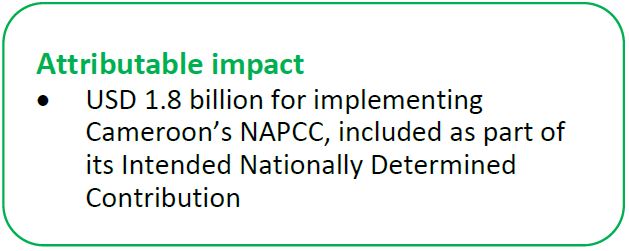Summary
GWP supported Cameroon in creating its first National Adaptation Plan for Climate Change (NAPCC), a strategic intervention comprised of 20 adaptation programmes. The country’s Intended Nationally Determined Contribution estimates that USD 1.8 billion in investments is required to implement the NAPCC.

Background
The magnitude and recurrence of floods in some parts of Cameroon and drought in others illustrate the danger climate change poses to human development challenges in Cameroon: from increased rainfall variability affecting agricultural to dust storms and flooding that affect infrastructure. Simulation models predict that climate risks will greatly affect ecosystems and economic sectors (agriculture, forestry, fishing, tourism), infrastructure (dams, roads, energy, water and sanitation) and areas related to human development (health, education, employment, gender). There is an urgent need to find the best strategies to integrate and strengthen climate change considerations in these sectors.
In recognition of this, the Government of Cameroon ratified the United Nations Framework Convention on Climate Change (UNFCCC) and has regularly participated its international Conferences of Parties (COP). Two types of actions are required: reduce the carbon emissions to slow down global warming, and implement climate change adaptation measures to minimize the damages of unavoidable climate related disasters. These are the primary objectives of Cameroon’s first National Adaptation Plan for Climate Change (NAPCC).
The development of the NAPCC was led by the Ministry of Environment, Protection of Nature and Sustainable Development (MINEPDED). The document was derived from wide ranging consultations that took place between October 2012 and May 2015.
Multidisciplinary experts were brought together to assemble the scientific documents and produce new baseline and projection studies about climate change impacts across the country’s five agro-ecological regions. Workshops involving more than 625 participants allowed for additional input and specific recommendations.
The proposals from these workshops were prioritised and synthesised to ensure consistency with the requirements of international conventions in the fields of environment and national development objectives prescribed by Vision 2035, a policy roadmap for becoming an emerging country by 2035.[1]
GWP Contribution
The development process of the NAPCC was a concerted effort between MINEPDED, the Government of Japan, GIZ, UNDP, and GWP. GWP assisted MINEPDED in mobilising stakeholders, mainstreaming water security issues in the document, refining the project ideas, and in estimating the investment required for the implementation of the NAPCC.
Through GWP’s Water Climate and Development Programme, GWP Cameroon supported the organisation of a national workshop to present and approve the country’s NAPCC in August 2014. The workshop brought together participants from sector ministries, regional and local authorities, education and research, the media, the private sector, civil society, and development partners.
GWP supported the technical review and finalisation of the NAPCC by providing one representative on the task force who was responsible for integrating the comments from the stakeholder approval workshop. The person also helped restructure the document to respect UNFCCC guidelines, and prioritised and estimated budgets for project ideas.
GWP continues to work with MINEPDEP in the development of a National Investment Plan (NIP) so that the NAPCC finds the financial resources for its implementation.
Furthermore, a collaboration agreement between GWP and UNDP was established in April 2014, with the purpose of facilitating National Adaptation Planning processes at different levels. This led to a capacity development programme on the “economics of climate change adaptation”. For this, 15 planning level staff from five state institutions in Cameroon were trained for 18 months. Two trainees worked with the GWP Cameroon team to develop and submit a EUR 420.000 water security and climate resilient project that was accepted for funding by the Climate Development Special Fund for Africa (ClimDev Africa).
Results
The NAPCC was formally adopted and endorsed in June 2015 by the MINEPDED and is now being implemented. It consists of a strategic intervention plan (2016-2025) which will be rolled out in two five-year action plans.
The first five-year action plan (2016-2020) includes 20 programme sheets: sheets 1 to 5 are inter-sectoral programmes (e.g., enhance the national climate monitoring and early warning systems). Sheets 6 to 20 are programmes ascribed to thematic sectors (e.g., agriculture, water supply and sanitation).
The NAPCC makes recommendations for combining sectoral administrations in their areas of competence, decentralized local authorities, civil society, and international organisations based in Cameroon. MINEPDED is responsible for programme coordination and entrusted with annual evaluation of implementation until 2020, thus building capacity for the formulation and implementation of the second five-year action plan.
The financial costs associated with the NAPCC are based on the recommendations of the World Bank to sub-Saharan African countries of spending USD 16 per person per year on climate change adaptation.[2] To that effect, the Government of Cameroon has included a USD 1.8 billion for the implementation of the NAPCC as part of its Intended Nationally Determined Contribution, i.e., a document with legal force under the UNFCCC in which Parties communicate their pledged undertakings in adaptation planning.[3]
The NAPCC is also intended as a “shopping document” capable of enabling the country to mobilize and benefit from various private and global funds to support adaptation to climate change for the least developed countries.
[1] Republic of Cameroon (2009). Cameroon Vision 2035.
[2] World Bank (2010) The cost to developing countries of adapting to climate change : New methods and estimates.
[3] United Nations Framework Convention on Climate Change (2014) Intended Nationally Determined Contributions (INDCs) available at: http://unfccc.int/focus/indc_portal/items/8766.php
Photo: Crumbling iron and concrete walking bridge crossing large river in rain forest of Cameroon, Africa - MostPhotos.com

